Slieve Gullion Winter Solstice Sunset - 23rd December 2011
The Passage Tomb on Slieve Gullion in Co. Armagh is the highest in Ireland, like at the larger Dowth Passage Tomb in the Boyne Valley, the setting sun around the time of the Winter Solstice illuminates the chamber.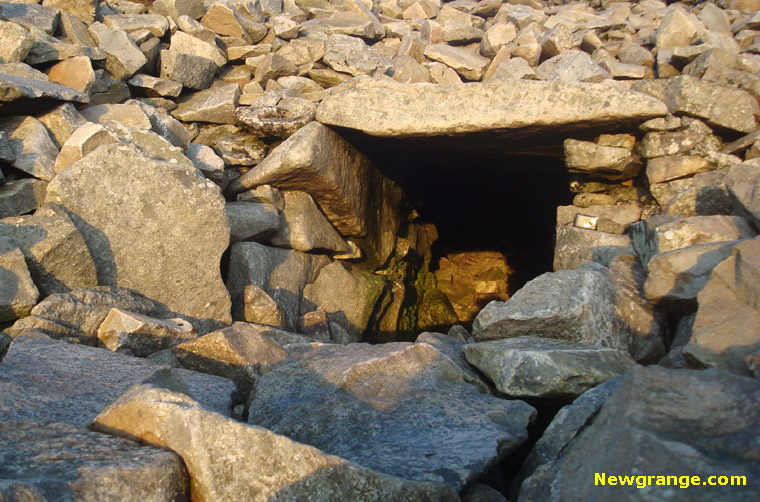
Beam of golden light from the setting sun entering the passage of the cairn on Slieve Gullion
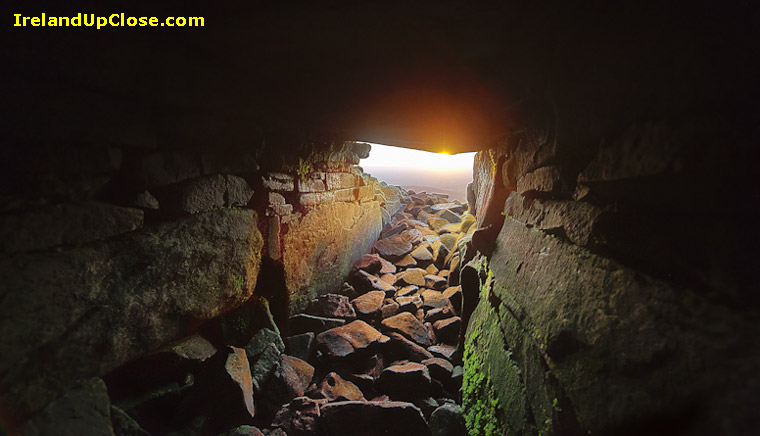
View of the Winter Solstice setting sun from inside the chamber - Photo by Robert Ardill
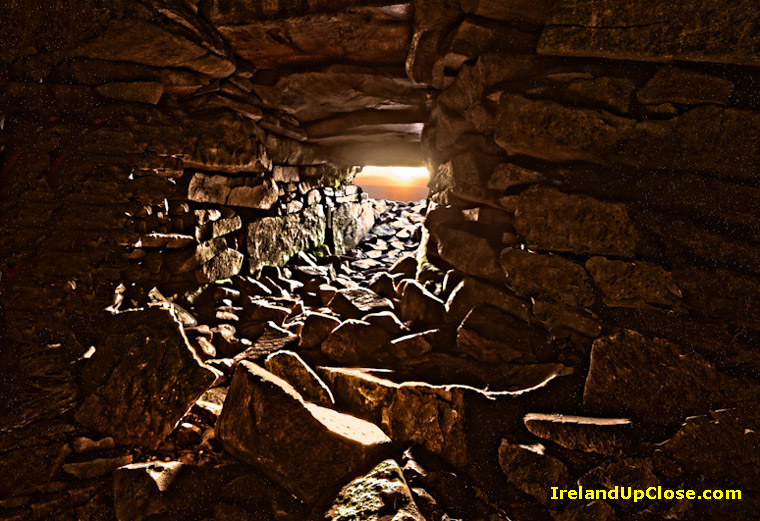
View of the Winter Solstice setting sun from inside the chamber - Photo by Robert Ardill

Beam of golden light from the setting sun in the cairn on Slieve Gullion
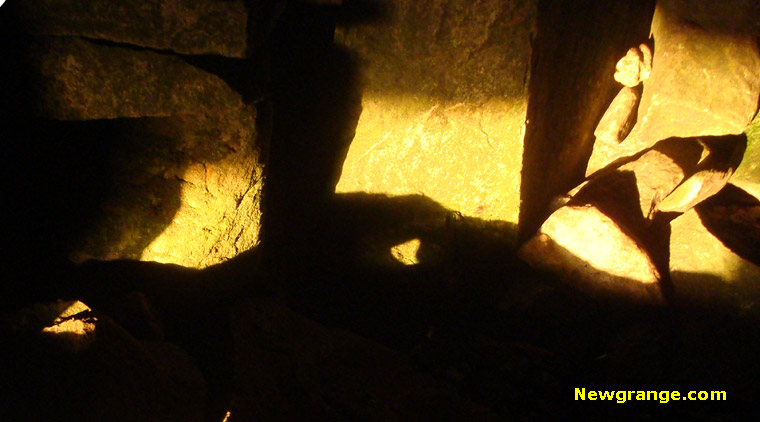
Beam of golden light from the setting sun in the cairn on Slieve Gullion
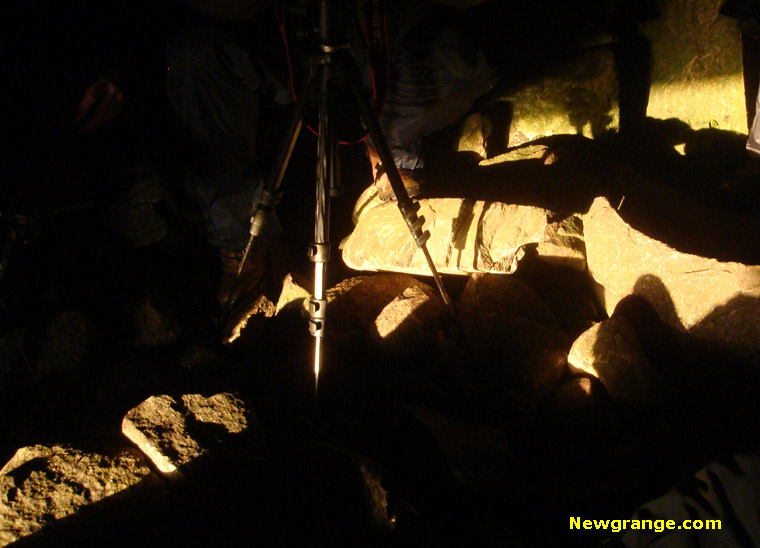
Beam from the setting sun at the back of the chamber complete with tripod for scale
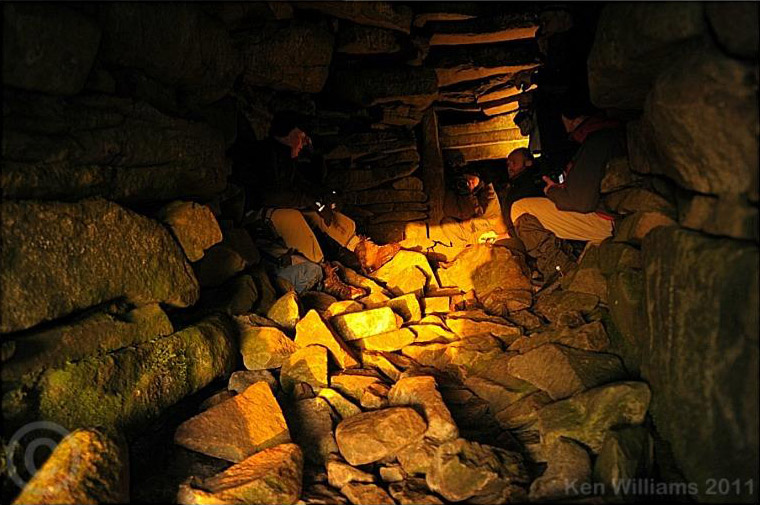
The cairn is known from legend as 'Cailleach Beara's House' - Photo by Ken Williams
Legend has it that the Cailleach Beara (a witch who transforms into a hare) tricked Finn McCool into jumping into the Mountain's lake, from which he emerges an old and withered man. The Fianna force the Cailleach Beara to restore Finn back to his former self but his hair remains white as an old man for the rest of his life.
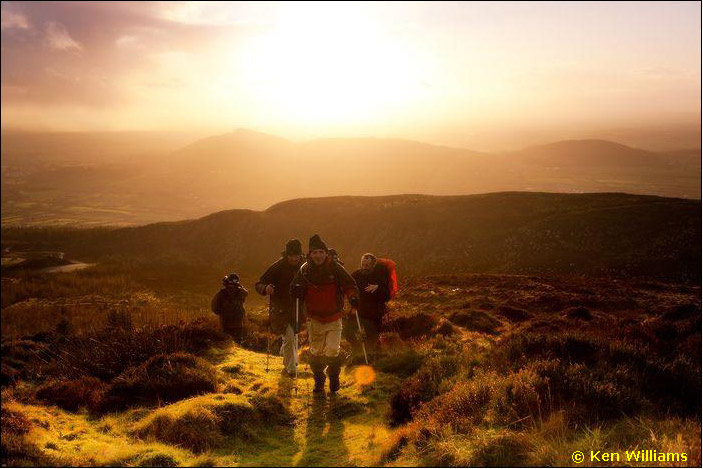
Photo by Ken Williams of the team making their way to the cairn in Slieve Gullion.
From the front: Raymond Manley, Michael Fox, Pat O'Rourke and Robert Ardill
The Cairn was excavated in 1961, the excavation report was published in the Ulster Journal of Archaeology Third Series, Vol. 26, (1963), pp. 19-40.
The Slieve Gullion Cairns
An introduction to The Slieve Gullion Cairns by A. E. P. Collins and B. C. S. WilsonSlieve Gullion has long been famed for the large passage-grave cairn sited on its southern summit. Although damaged, enough is preserved of both passage and chamber for it to be clear that both in size and in building technique it is one of the major passage-graves of Ireland. It was thus felt that excavation was necessary both to search for evidence of funerary deposits and to reveal as much as possible of its construction, so that an adequate record could be included in the County Armagh Survey. And while equipment and labour were assembled for this task it seemed wise to undertake the excavation of the smaller round cairn on the northern summit.
Special difficulties were foreseen in working on so lofty and exposed a hilltop and it was decided to try to overcome these by the use of student labour encamped on the mountain. A camp was therefore established on the northern end of the mountain about 600 ft, below summit level and some thirty students from the Archaeology and Geography Departments of Queen's University had their first experience of a training excavation during the period June 17th — July 20th, 1961. Our thanks are due to all these and to a few other friends who braved bad weather and difficult and dangerous working conditions and to two local farmers, Messrs. Joseph Hughes and Sean O'Grady; the last of these, at considerable risk, look his farm tractor with equipment almost to the summit.

An Cailleach
From the earliest times, the Cailleach has been venerated as a mother Goddess of Ireland. In this card from Art Through the Eyes of the Soul Oracle Cards she is seen in her ancient cairn on Slieve Gullion, in County Armagh. On the horizon can be seen the cairn topped hills of Slieve na Cailleach, at Loughcrew, Oldcastle, County Meath, which are also named in honor of her.Voices from the Dawn
An exploration of the site in 1961 encountered obstacles unique to this tomb, the highest major excavation yet undertaken in Ireland. In contrast to the usual method of deploying workers each day to the dig site, here they established a 30-person camp of "student labour" just 600 ft below the top of the mountain. They found the chamber to be 3.66 m (12 ft) wide, with a corbelled roof as much as 4.3 m (14 ft) above them, which has now mostly been replaced by concrete slabs.The outside diameter of the cairn is 30 m (97 ft), with a height of 5 m (16 ft). They discovered in the centre of the passage tomb two large blocks of stone, evidentially used as basins, with shallow depressions hammered into their natural shapes. An earlier investigator had found a third, smaller basin, cracked into two pieces. Some pieces of worked flint as well as a barbed-end arrowhead were also discovered, the meagre remnants that survived the centuries of tomb raiding. Radiocarbon dating from the tomb's excavation suggested its construction dated from c. 3500-2900 BCE.
For excellent Virtual Reality Panoramas and the Mythology of Slieve Gullion see VoicesFromTheDawn.com
Boyne Valley Private Day Tour
 Immerse yourself in the rich heritage and culture of the Boyne Valley with our full-day private tours.
Visit Newgrange World Heritage site, explore the Hill of Slane, where Saint Patrick famously lit the Paschal fire.
Discover the Hill of Tara, the ancient seat of power for the High Kings of Ireland.
Book Now
Immerse yourself in the rich heritage and culture of the Boyne Valley with our full-day private tours.
Visit Newgrange World Heritage site, explore the Hill of Slane, where Saint Patrick famously lit the Paschal fire.
Discover the Hill of Tara, the ancient seat of power for the High Kings of Ireland.
Book Now
Home
| Visitor Centre
| Tours
| Winter Solstice
| Solstice Lottery
| Images
| Local Area
| News
| Knowth
| Dowth
| Articles
| Art
| Books
| Directions
| Accommodation
| Contact
